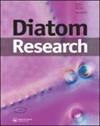16株单克隆pennate硅藻中期培养的形态变异和遗传标记稳定性
IF 1.3
3区 生物学
Q2 MARINE & FRESHWATER BIOLOGY
引用次数: 2
摘要
单克隆硅藻菌株是结合分子和形态学数据进行综合分类研究的基础,以获得更好的分类分辨率和鉴定。由于物种内部和物种之间特征的可变性,基于截头体的形态特征识别硅藻是困难的。培养时间越长,无性繁殖过程中细胞大小减少的越多。细胞的许多分裂使鉴定变得复杂,因为在不同的分类群中,截头体的形态特征以不同的速率变化,并可能形成畸形。形态变异性提出了所研究的遗传标记在培养时间跨度内是否稳定的问题。16个单克隆三角藻菌株被鉴定为6属10个不同物种,培养时间长达18或24个月。结果表明,18S-V4、rbcL和psbA标记的分子数据在所有分类群的整个培养时间内都是稳定的。每六个月拍摄一次菌株瓣膜的图像,并进行形态学检查。根据培养开始以来的时间,形态特征表现出高度的可变性,特别是在长度和形状上,而纹、肋或腓骨的宽度和数量则更稳定,这取决于分类单元和菌株。有限的时间跨度和良好的培养条件似乎是避免畸形性截头体产生的先决条件。在一个独特的实验设计中,平行文化的结果与处理单一菌株或特殊认知兴趣的文献中的观察结果进行了比较。本文章由计算机程序翻译,如有差异,请以英文原文为准。
Morphological variability and genetic marker stability of 16 monoclonal pennate diatom strains under medium-term culture
Monoclonal diatom strains are the basis for integrative taxonomical studies combining molecular and morphological data for better taxonomic resolution and identification. The identification of diatoms, based on morphological features of the frustule, is difficult due to the variability of characters within and amongst species. The longer the cultivation time, the more cell size is reduced during asexual reproduction. Many divisions of the cell complicate identification as morphological characters of the frustule change at different rates in different taxa and teratologies can develop. Morphological variability raises the question whether the investigated genetic markers are stable over the cultivation time span. Sixteen monoclonal pennate diatom strains, identified as 10 different species in six genera, were cultivated for up to 18 or 24 months. It was shown that molecular data for the 18S-V4, rbcL, and psbA markers were stable for the entire cultivation time of all taxa. Images of the valves of the strains were taken every six months and examined morphometrically. Depending on the time since the start of the cultures, the morphological features showed high variability, particularly in length and shape, whereas width and number of striae, costae or fibulae were more stable, depending on the taxon and strain. A limited time span and good culture conditions seem to be prerequisite to avoid the production of teratological frustules. The results of parallel cultures in a unique experimental design are compared to observations from the literature dealing with single strains or special cognitive interests.
求助全文
通过发布文献求助,成功后即可免费获取论文全文。
去求助
来源期刊

Diatom Research
生物-海洋与淡水生物学
CiteScore
2.70
自引率
16.70%
发文量
27
审稿时长
>12 weeks
期刊介绍:
Diatom Research is the journal of the International Society for Diatom Research. The journal is published quarterly, in March, June, September and December, and welcomes manuscripts on any aspect of diatom biology.
In addition to full-length papers, short notes and reviews of recent literature are published which need not contain all the sections required for full-length papers; we see these as being necessary to record information which is of interest but which cannot be followed up in detail. Discursive “Opinion” papers are encouraged which would not necessarily follow the normal lay-out. If extremely long papers are to be offered, the author(s) should contact the editors first to discuss any problems. Book reviews, obituaries and meeting reports can be published. All papers will be subject to critical review by the editors and referees, as appropriate to their content. Papers will be accepted in English only.
 求助内容:
求助内容: 应助结果提醒方式:
应助结果提醒方式:


